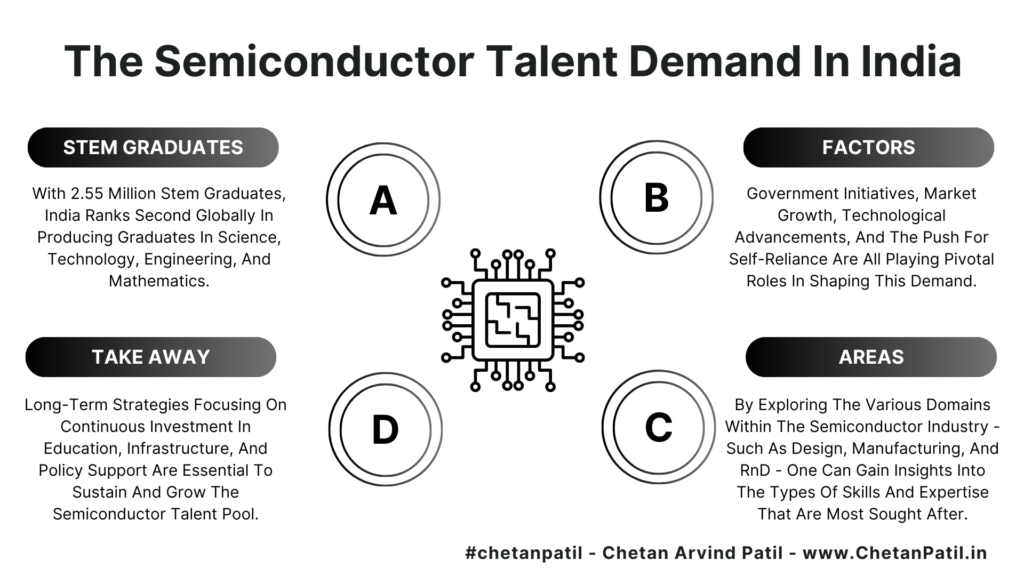Image Generated Using DALL-E
India And Semiconductor
India’s semiconductor industry is on the cusp of a significant transformation, driven by a huge demand for talent and rapid technological advancements. With 2.55 million STEM graduates yearly, India ranks second globally in producing Science, Technology, Engineering, and Mathematics graduates.
As the world increasingly relies on semiconductors for everything from smartphones to electric vehicles, India’s role as a key player in this global ecosystem becomes increasingly critical.
Thus, exploring the multifaceted dynamics of the demand for semiconductor talent in India is essential, shedding light on the historical context, current landscape, and the factors fueling this demand.
Semiconductor Background In India
India’s journey in the semiconductor industry began in the late 20th century, marked by the establishment of key research institutions and the advent of multinational semiconductor companies setting up operations in the country. Initially, India’s role was primarily confined to software services and design, leveraging its strong IT industry.
Over the years, however, the landscape has evolved. Government initiatives, such as the Make in India campaign and semiconductor fabrication labs’ establishment have been pivotal in fostering a more comprehensive semiconductor ecosystem. Today, India is a hub for semiconductor design and makes strides in manufacturing and research, positioning itself as a critical player in the global supply chain.
STEM Graduates In India
India is a powerhouse in STEM education, with more than 2.55 million graduates yearly, second only to China. This significant pool of STEM talent positions India as a crucial player in the global semiconductor industry. The abundance of skilled graduates from Indian universities ensures a steady supply of engineers, researchers, and technicians to fuel the semiconductor sector’s growth.
India’s prominence in STEM education underpins its potential to address the global semiconductor talent shortage. As the industry evolves with advancements in AI, the demand for highly specialized knowledge and skills increases. Indian STEM graduates, equipped with strong technical backgrounds, are thus well-suited to meet these needs, driving innovation and efficiency in semiconductor design and manufacturing.

Moreover, India’s educational institutions and government initiatives foster an environment conducive to technological advancements. Partnerships between academia and industry, alongside government incentives, are crucial in enhancing the skill sets of Indian STEM graduates, making them even more valuable to the semiconductor industry.
In the near-term, India’s substantial number of STEM graduates will play a pivotal role in the semiconductor sector. Leveraging this talent pool can significantly impact global semiconductor supply chains, ensuring sustained innovation and competitiveness in this critical field.
Factors Driving Semiconductor Growth In India
Understanding the factors driving the demand for semiconductor talent in India is crucial to appreciating the industry’s growth dynamics. Government initiatives, which are significant, market growth, which is promising, technological advancements, and the push for self-reliance are all playing pivotal roles in shaping this demand.
These elements collectively create a fertile ground for the semiconductor sector to flourish, necessitating a diverse and skilled workforce.
| Factor | Description |
|---|---|
| Government Initiatives | Policies such as the Production Linked Incentive (PLI) scheme and Electronics Manufacturing Clusters (EMC) scheme aim to attract investments and boost local production capabilities, fostering a conducive environment for semiconductor companies. |
| Market Growth | The global semiconductor market is expanding due to the proliferation of digital technologies like AI. This growth increases the demand for skilled professionals to design and manufacture semiconductors. |
| Technological Advancements | Emerging technologies require advanced semiconductor solutions, driving the need for highly skilled workers. Indian educational institutions are focusing on these technologies, producing graduates equipped to meet industry needs. |
| Self-Reliance | Efforts to reduce dependency on foreign semiconductor imports and enhance local capabilities drive demand for skilled talent. Initiatives to promote domestic semiconductor manufacturing and design are crucial in achieving self-reliance. |

Areas Of Semiconductor Talent Demand
Understanding the areas where talent demand is most pronounced in the semiconductor industry is paramount. By delving into the various domains – design, manufacturing, and RnD – one can pinpoint the skills and expertise in high demand.
This detailed examination will highlight the critical roles and opportunities available, shedding light on how India’s educational institutions and industry partnerships prepare to meet these demands.
| Section | Details |
|---|---|
| Areas Of Talent Demand | Design: Demand for roles such as design engineers, verification engineers, and system architects has surged, driven by AI and computing advancements. Manufacturing: Rising demand for process engineers, equipment engineers, and technicians due to government initiatives and new fab setups. RnD: High demand for materials science, quantum computing, and nanotechnology researchers to drive innovation. |
| Education And Skill Development | Educational Institutions: Premier institutions like IITs, NITs, and leading universities offer specialized electronics and engineering programs. Skill Gaps: Additional training in VLSI design, semiconductor fabrication, and advanced materials science is needed. Industry-Academia Collaboration: These partnerships, fostering sponsored research, internships, and workshops, are key to aligning academic programs with the dynamic needs of the industry, leading to a more skilled workforce. |
| Challenges | Brain Drain: The migration of skilled professionals abroad for better opportunities; the need to create attractive work environments in India. Infrastructure: There is a need for substantial investment in advanced machinery and facilities for semiconductor fabs and research labs. Retention: Competitive salaries, a positive work culture, continuous learning, and clear career progression are essential to retain talent. |
| Opportunities And Future Outlook | Startups and Innovation: Emergence of startups focusing on AI, IoT, and specialized semiconductor applications, supported by government initiatives. Global Competitiveness: The industry’s strength lies in its ability to leverage highly skilled professionals, a robust education infrastructure, and unwavering government support, all of which are propelling it towards becoming a semiconductor global leader. Long-term Strategies: The industry is committed to a path of continuous investment in education, infrastructure, and industry collaboration, bolstered by policies that foster innovation and ease of doing business. |
Take Away
For sure, India is pivotal in the global semiconductor industry, driven by a robust educational infrastructure, supportive government policies, and a market demand. The nation’s significant pool of STEM graduates positions it to meet the growing global and domestic demand for semiconductor talent. However, challenges such as brain drain, infrastructure limitations, and retention issues must be addressed to fully capitalize on this potential.
By fostering solid collaborations between industry and academia, investing in advanced training programs, and creating a conducive work environment, India can bridge the existing skill gaps and enhance its competitiveness on the global stage. The rise of startups and innovation hubs, supported by government initiatives, further underscores the country’s potential to lead in semiconductor design, manufacturing, and RnD.
Long-term strategies focusing on continuous investment in education, infrastructure, and policy support are essential to sustain and grow the semiconductor talent pool. As India navigates these challenges and opportunities, it is well-positioned to become a global powerhouse in the semiconductor industry, driving innovation and economic growth for years.





